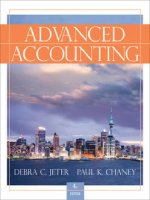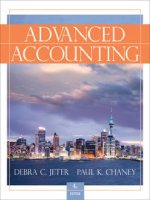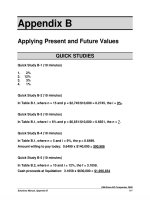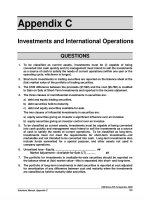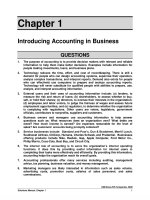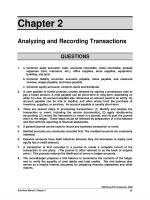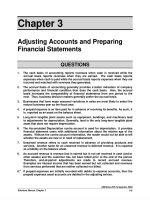Solution manual financial accounting 4e by wild chapter01
Bạn đang xem bản rút gọn của tài liệu. Xem và tải ngay bản đầy đủ của tài liệu tại đây (1.93 MB, 53 trang )
To download more slides, ebook, solutions and test bank, visit
Chapter 1
Introducing Accounting in Business
QUESTIONS
1.
The purpose of accounting is to provide decision makers with relevant and reliable
information to help them make better decisions. Examples include information for
people making investments, loans, and business plans.
2.
Technology reduces the time, effort, and cost of recordkeeping. There is still a
demand for people who can design accounting systems, supervise their operation,
analyze complex transactions, and interpret reports. Demand also exists for people
who can effectively use computers to prepare and analyze accounting reports.
Technology will never substitute for qualified people with abilities to prepare, use,
analyze, and interpret accounting information.
3.
External users and their uses of accounting information include: (a) lenders, to
measure the risk and return of loans; (b) shareholders, to assess whether to buy,
sell, or hold their shares; (c) directors, to oversee their interests in the organization;
(d) employees and labor unions, to judge the fairness of wages and assess future
employment opportunities; and (e) regulators, to determine whether the organization
is complying with regulations. Other users are voters, legislators, government
officials, contributors to nonprofits, suppliers and customers.
4.
Business owners and managers use accounting information to help answer
questions such as: What resources does an organization own? What debts are
owed? How much income is earned? Are expenses reasonable for the level of
sales? Are customers‘ accounts being promptly collected?
5.
Service businesses include: Standard and Poor‘s, Dun & Bradstreet, Merrill Lynch,
Southwest Airlines, CitiCorp, Humana, Charles Schwab, and Prudential. Businesses
offering products include Nike, Reebok, Gap, Apple Computer, Ford Motor Co.,
Philip Morris, Coca-Cola, Best Buy, and Circuit City.
6.
The internal role of accounting is to serve the organization‘s internal operating
functions. It does this by providing useful information for internal users in
completing their tasks more effectively and efficiently. By providing this information,
accounting helps the organization reach its overall goals.
7.
Accounting professionals offer many services including auditing, management
advice, tax planning, business valuation, and money management.
8.
Marketing managers are likely interested in information such as sales volume,
advertising costs, promotion costs, salaries of sales personnel, and sales
commissions.
©McGraw-Hill Companies, 2008
Solutions Manual, Chapter 1
1
To download more slides, ebook, solutions and test bank, visit
9.
Accounting is described as a service activity because it serves decision makers by
providing information to help them make better business decisions.
10. Some accounting related professions include consultant, financial analyst,
underwriter, financial planner, appraiser, FBI investigator, market researcher, and
system designer.
11. Ethics rules require that auditors avoid auditing clients in which they have a direct
investment, or if the auditor‘s fee is dependent on the figures in the client‘s reports.
This will prevent others from doubting the quality of the auditor‘s report.
12. In addition to preparing tax returns, tax accountants help companies and individuals
plan future transactions to minimize the amount of tax to be paid. They are also
actively involved in estate planning and in helping set up organizations. Some tax
accountants work for regulatory agencies such as the IRS or the various state
departments of revenue. These tax accountants help to enforce tax laws.
13. The objectivity principle means that financial statement information is supported by
independent, unbiased evidence other than someone‘s opinion or imagination. This
principle increases the reliability and verifiability of financial statement information.
14. This treatment is justified by both the cost and going-concern principles.
15. The revenue recognition principle provides guidance for managers and auditors so
they know when to recognize revenue. If revenue is recognized too early, the
business looks more profitable than it is. On the other hand, if revenue is
recognized too late the business looks less profitable than it is. This principle
demands that revenue be recognized when it is both earned and can be measured
reliably. The amount of revenue should equal the value of the assets received or
expected to be received from the business‘s operating activities covering a specific
time period.
16. Business organizations can be organized in one of three basic forms: sole
proprietorship, partnership, or corporation. These forms have implications for legal
liability, taxation, continuity, number of owners, and legal status as follows:
Proprietorship
Business entity
Legal entity
Limited liability
Unlimited life
Business taxed
One owner allowed
yes
no
no*
no
no
yes
Partnership
yes
no
no*
no
no
no
Corporation
yes
yes
yes
yes
yes
yes
*Proprietorships and partnerships that are set up as LLCs provide limited liability.
17. (a) Assets are resources owned or controlled by a company that are expected to
yield future benefits. (b) Liabilities are creditors‘ claims on assets that reflect
obligations to provide assets, products or services to others. (c) Equity is the
owner‘s claim on assets and is equal to assets minus liabilities. (d) Net assets refer
to equity.
18. Equity is increased by investments by the owner (via stock issuances) and also by
net income. It is decreased by dividends to stockholders and by a net loss (which is
the excess of expenses over revenues).
©McGraw-Hill Companies, 2008
2
Financial Accounting, 4th Edition
To download more slides, ebook, solutions and test bank, visit
19. Accounting principles consist of (a) general and (b) specific principles. General
principles are the basic assumptions, concepts, and guidelines for preparing
financial statements. They stem from long-used accounting practices. Specific
principles are detailed rules used in reporting on business transactions and events.
They usually arise from the rulings of authoritative and regulatory groups such as
the Financial Accounting Standards Board or the Securities and Exchange
Commission.
20. Revenue (or sales) is the amount received from selling products and services.
21. Net income (also called income, profit or earnings) equals revenues minus expenses
(if revenues exceed expenses). Net income increases equity. If expenses exceed
revenues, the company has a Net Loss. Net loss decreases equity.
22. The four basic financial statements are: income statement, statement of retained
earnings, balance sheet, and statement of cash flows.
23. An income statement reports a company‘s revenues and expenses along with the
resulting net income or loss over a period of time.
24. Rent expense, utilities expense, administrative expenses, advertising and promotion
expenses, maintenance expense, and salaries and wages expenses are some
examples of business expenses.
25. The statement of retained earnings explains the changes in retained earnings from
net income or loss, and from any dividends over a period of time.
26. The balance sheet describes a company‘s financial position (types and amounts of
assets, liabilities, and equity) at a point in time.
27. The statement of cash flows reports on the cash inflows and outflows from a
company‘s operating, investing, and financing activities.
28. Return on assets, also called return on investment, is a profitability measure that is
useful in evaluating management, analyzing and forecasting profits, and planning
activities. It is computed as net income divided by the average total assets. For
example, if we have an average annual balance of $100 in a bank account and it
earns interest of $5 for the year, then our return on assets is $5 / $100 or 5%. The
return on assets is a popular measure for analysis because it allows us to compare
companies of different sizes and in different industries.
29A. Return refers to income, and risk is the uncertainty about the return we expect to
make. The lower the risk of an investment, the lower the expected return. For
example, savings accounts pay a low return because of the low risk of a bank not
returning the principal with interest. Higher risk implies higher, but riskier, expected
returns.
30B. Organizations carry out three major activities: financing, investing, and operating.
Financing provides the means used to pay for resources. Investing refers to the
acquisition and disposing of resources necessary to carry out the organization‘s
plans. Operating activities are the actual carrying out of these plans. (Planning is the
glue that connects these activities, including the organization’s ideas, goals and
strategies.)
©McGraw-Hill Companies, 2008
Solutions Manual, Chapter 1
3
To download more slides, ebook, solutions and test bank, visit
31B. An organization‘s financing activities (liabilities and equity) pay for investing
activities (assets). An organization cannot have more or less assets than its
liabilities and equity combined and, similarly, it cannot have more or less liabilities
and equity than its total assets. This means: assets = liabilities + equity. This
relation is called the accounting equation (also called the balance sheet equation),
and it applies to organizations at all times.
32. The dollar amounts in Best Buy‘s financial statements are rounded to the nearest
$1,000,000. Best Buy‘s consolidated statement of earnings (or income statement)
covers the fiscal year (consisting of 52 weeks) ended February 26, 2005. Best Buy
also reports comparative income statements for the previous two years.
33. At February 28, 2005, Circuit City had (in thousands) assets of $3,789,382, liabilities
of $1,701,948, and equity of $2,087,434.
34. The independent auditor for Apple Computer, Inc., is KPMG LLP. The auditor
expressly states that ―our responsibility is to express an opinion on these
consolidated financial statements based on our audits.‖ The auditor also states that
―these consolidated financial statements are the responsibility of the Company‘s
management.‖
©McGraw-Hill Companies, 2008
4
Financial Accounting, 4th Edition
To download more slides, ebook, solutions and test bank, visit
QUICK STUDIES
Quick Study 1-1
(a) and (b)
GAAP:
Generally Accepted Accounting Principles
Importance: GAAP are the rules that specify acceptable accounting
practices.
SEC:
Securities and Exchange Commission
Importance: The SEC is charged by Congress to set reporting rules for
organizations that sell ownership shares to the public. The
SEC delegates part of this responsibility to the FASB.
FASB:
Financial Accounting Standards Board
Importance: FASB is an independent group of full-time members who are
responsible for setting accounting rules.
IASB:
International Accounting Standards Board.
Importance: Its purpose is to issue standards that identify preferred
practices in the desire of harmonizing accounting practices
across different countries. The vast majority of countries and
financial exchanges support its activities and objectives.
Quick Study 1-2
a.
b.
c.
d.
e.
f.
E
E
E
E
I
E
g.
h.
i.
j.
k.
l.
E
E
I
E
E
I
Quick Study 1-3
Internal controls serve several purposes:
They involve monitoring an organization‘s activities to promote
efficiency and to prevent wrongful use of its resources.
They help ensure the validity and credibility of accounting reports.
They are often crucial to effective operations and reliable reporting.
More generally, the absence of internal controls can adversely affect the
effectiveness of domestic and global financial markets.
©McGraw-Hill Companies, 2008
Solutions Manual, Chapter 1
5
To download more slides, ebook, solutions and test bank, visit
Quick Study 1-4
Accounting professionals practice in at least four main areas. These four
areas, along with a listing of some work opportunities in each, are:
1. Financial accounting
Preparation
Analysis
Auditing (external)
Consulting
Investigation
2. Managerial accounting
Cost accounting
Budgeting
Auditing (internal)
Consulting
3. Tax accounting
Preparation
Planning
Regulatory
Consulting
Investigation
4. Accounting-related
Lending
Consulting
Analyst
Investigator
Appraiser
Quick Study 1-5
The choice of an accounting method when more than one alternative method
is acceptable often has ethical implications. This is because accounting
information can have major impacts on individuals‘ (and firms‘) well-being.
To illustrate, many companies base compensation of managers on the amount
of reported income. When the choice of an accounting method affects the
amount of reported income, the amount of compensation is also affected.
Similarly, if workers in a division receive bonuses based on the division‘s
income, its computation has direct financial implications for these individuals.
©McGraw-Hill Companies, 2008
6
Financial Accounting, 4th Edition
To download more slides, ebook, solutions and test bank, visit
Quick Study 1-6
a.
b.
c.
Revenue recognition principle
Cost principle (also called historical cost)
Business entity principle
Quick Study 1-7
Assets
=
Liabilities
+
Equity
$700,000
(a) $280,000
$420,000
$500,000
(b) $250,000
(b) $250,000
Quick Study 1-8
Assets
(b)
=
Liabilities
+
Equity
$75,000
(a) $35,000
$40,000
$95,000
$25,000
$70,000
$20,000
(c) $65,000
$85,000
Quick Study 1-9
(a)
(b)
Examples of business transactions that are measurable include:
Selling products and services.
Collecting funds from dues, taxes, contributions, or investments.
Borrowing money.
Purchasing products and services.
Examples of business events that are measurable include:
Decreases in the value of securities (assets).
Bankruptcy of a customer owing money.
Technological advances rendering patents (or other assets)
worthless.
An ―act of God‖ (casualty) that destroys assets.
©McGraw-Hill Companies, 2008
Solutions Manual, Chapter 1
7
To download more slides, ebook, solutions and test bank, visit
Quick Study 1-10
a. For September 25, 2004, the account and its dollar amount (in millions)
for Apple Computer are:
(1)
Assets
=
$8,050
(2)
Liabilities
=
$2,974
(3)
Equity
=
$5,076
b. Using Apple‘s amounts from (a) we verify that (in millions):
Assets
=
Liabilities
+
Equity
$8,050
=
$2,974
+
$5,076
Quick Study 1-11
[Code: Income statement (I), Balance sheet (B), Statement of retained earnings (E), or
Statement of cash flows (CF).]
a.
b.
c.
B
CF
E*
d.
e.
f.
B
I
B
g.
h.
i.
CF
I
B
*The more advanced student might know that this item could also appear in CF.
Quick Study 1-12
Net income
Return on assets = Average assets =
$5,001
$36,672
= 13.6%
Interpretation: Its return of 13.6% is above the 12% of its competitors. Home
Depot‘s performance can be rated as good.
©McGraw-Hill Companies, 2008
8
Financial Accounting, 4th Edition
To download more slides, ebook, solutions and test bank, visit
EXERCISES
Exercise 1-1 (10 minutes)
1.
2.
3.
4.
B
A
B
B
5.
6.
7.
8.
C
C
A
A
Exercise 1-2 (20 minutes)
External users and some questions they seek to answer with accounting
information include:
1. Shareholders (investors), who seek answers to questions such as:
a. Are resources owned by a business adequate to carry out plans?
b. Are the debts owed excessive in amount?
c. What is the current level of income (and its components)?
2. Creditors, who seek answers for questions such as:
a. Does the business have the ability to repay its debts?
b. Can the business take on additional debt?
c. Are resources sufficient to cover current amounts owed?
3. Employees, who seek answers to questions such as:
a. Is the business financially stable?
b. Can the business afford to pay higher salaries?
c. What are growth prospects for the organization?
Exercise 1-3 (20 minutes)
a.
Situations involving ethical decision making in coursework include
performing independent work on examinations and individually
completing assignments/projects. It can also extend to promptly
returning reference materials so others can enjoy them, and to properly
preparing for class to efficiently use the time and question period to not
detract from others‘ instructional benefits.
b.
Managers face several situations demanding ethical decision making in
their dealings with employees. Examples include fairness in performance
evaluations, salary adjustments, and promotion recommendations. They
can also include avoiding any perceived or real harassment of employees
by the manager or any other employees. It can also include issues of
confidentiality regarding personal information known to managers.
©McGraw-Hill Companies, 2008
Solutions Manual, Chapter 1
9
To download more slides, ebook, solutions and test bank, visit
Exercise 1-3—concluded
c.
Accounting professionals who prepare tax returns can face situations
where clients wish to claim deductions they cannot substantiate. Also,
clients sometimes exert pressure to use methods not allowed or
questionable under the law. Issues of confidentiality also arise when
these professionals have access to clients‘ personal records.
d.
Auditing professionals with competing audit clients are likely to learn
valuable information about each client that the other clients would benefit
from knowing. In this situation the auditor must take care to maintain the
confidential nature of information about each client.
Exercise 1-4 (10 minutes)
a.
b.
c.
d.
Corporation
Sole proprietorship
Corporation
Partnership
e.
f.
g.
Sole proprietorship
Sole proprietorship
Corporation
Exercise 1-5 (10 minutes)
Code
Description
Principle
E
1. Usually created by a pronouncement from an
authoritative body.
Specific accounting
principle
G
2. Financial statements reflect the assumption that
the business continues operating.
Going-concern
principle
A
3. Derived from long-used and generally accepted
accounting practices.
General accounting
principle
C
4. Every business is accounted for separately from
its owner or owners.
Business entity
principle
D
5. Revenue is recorded only when the earnings
process is complete.
Revenue recognition
principle
B
6. Information is based on actual costs incurred in
transactions.
Cost principle
F
7. Financial statement information is supported by
evidence other than someone‘s opinion or belief.
Objectivity principle
Exercise 1-6 (10 minutes)
1.
2.
3.
C
F
D
4.
5.
A
G
©McGraw-Hill Companies, 2008
10
Financial Accounting, 4th Edition
To download more slides, ebook, solutions and test bank, visit
Exercise 1-7 (10 minutes)
Assets
(a) $ 65,000
$100,000
$154,000
=
=
=
=
Liabilities
$ 20,000
$ 34,000
(c) $114,000
+
+
+
+
Equity
$45,000
(b) $66,000
$40,000
Exercise 1-8 (15 minutes)
Examples of transactions that fit each case include:
a. Cash dividends (or some other asset) paid to the stockholders of the
business; OR, the business incurs an expense paid in cash.
b. Business purchases equipment (or some other asset) on credit.
c.
Business signs a note payable to extend the due date on an account
payable.
d. Business pays an account payable (or some other liability) with cash
(or some other asset).
e. Business purchases office supplies (or some other asset) for cash (or
some other asset).
f.
Business incurs an expense that is not yet paid (for example, when
employees earn wages that are not yet paid).
g. Stockholders invest cash (or some other asset) in the business; OR,
the business earns revenue and accepts cash (or another asset).
Exercise 1-9 (20 minutes)
a. Started the business with the owner investing $40,000 cash in
exchange for common stock.
b. Purchased office supplies for $3,000 by paying $2,000 cash and putting
the remaining $1,000 balance on credit.
c. Purchased office furniture by paying $8,000 cash.
d. Billed a customer $6,000 for services earned.
e.
Provided services for $1,000 cash.
©McGraw-Hill Companies, 2008
Solutions Manual, Chapter 1
11
To download more slides, ebook, solutions and test bank, visit
Exercise 1-10 (20 minutes)
a. Using the accounting equation:
Assets
=
Liabilities
$123,000
=
$47,000
Thus, equity = $76,000
+
+
Equity
?
b. Using the accounting equation at the beginning of the year:
Assets
=
Liabilities
+
Equity
$300,000
=
?
+
$100,000
Thus, beginning liabilities = $200,000
Using the accounting equation at the end of the year:
Assets
=
Liabilities
+
Equity
$300,000 + $80,000 = $200,000+ $50,000 +
?
$380,000
=
$250,000
+
?
Thus, ending equity = $130,000
Alternative approach to solving part (b):
Assets($80,000) = Liabilities($50,000) + Equity(?)
where ― ‖ refers to ―change in.‖
Thus: Ending Equity = $100,000 + $30,000 = $130,000
c. Using the accounting equation at the end of the year:
Assets
=
Liabilities
+
Equity
$190,000
=
$70,000 - $5,000
+
?
$190,000
=
$65,000
+
$125,000
Using the accounting equation at the beginning of the year:
Assets
=
Liabilities
+
Equity
$190,000 - $60,000 =
$70,000
+
?
$130,000
=
$70,000
+
?
Thus: Beginning Equity
= $60,000
©McGraw-Hill Companies, 2008
12
Financial Accounting, 4th Edition
To download more slides, ebook, solutions and test bank, visit
Exercise 1-11 (30 minutes)
Accounts
Cash
a.
+$60,000
b.
–
Bal.
c.
f.
61,000 +
–
Bal.
g.
Bal.
h.
+
Bal.
5,000 57,000 +
– 10,000
Bal.
j.
3,000
52,000 +
Bal.
i.
6,000
55,000 +
–
47,000 +
–
15,000 =
+
10,000
+
25,000 =
______
61,000 +
Bal.
+
2,500
_______ +
1,000
$46,000 +
=
Accounts
Payable
+
+
$8,000
8,000 +
______ +
8,000 +
______
6,000
______
5,000
______
3,000 +
31,000 =
______
10,000 +
_______
10,000 +
_______
10,000 +
_______
31,000 =
31,000 =
3,000 +
+$10,000
25,000 =
8,000 +
______
+
25,000 =
______
______
10,000 +
_______
10,000 +
_______
10,000 +
– 10,000
31,000 =
______
Common
Stock
Divi-
– dends
+ Revenue – Expenses
+ $75,000
______
58,500 +
Bal.
e.
1,500
_______
+
Equipment
+ $15,000 =
58,500 +
Bal.
d.
+ Receivable +
0 +
_______
$3,000 + $31,000 = $
______
– $1,500
75,000
–
1,500
______
_____
–
75,000
1,500
______
+
75,000
+
2,500 –
1,500
______
+
8,000
_____
75,000
+
10,500 –
1,500
_____
_____
10,500 –
1,500
_____ –
3,000
10,500 –
4,500
_____
_____
10,500 –
4,500
_____
_____
10,500 –
4,500
_____
_____
______
75,000
+
______
75,000
+
______
75,000
+
______
75,000
+
______ – $1,000
$2,500
_____
0 + $75,000 – $1,000 + $10,500 – $4,500
Exercise 1-12 (15 minutes)
a. Purchased land for $4,000 cash.
b. Purchased $1,000 of office supplies on credit.
c. Billed a client $1,900 for services provided.
d. Paid the $1,000 account payable created by the credit purchase of
office supplies in transaction b.
e. Collected $1,900 cash for the billing in transaction c.
©McGraw-Hill Companies, 2008
Solutions Manual, Chapter 1
13
To download more slides, ebook, solutions and test bank, visit
Exercise 1-13 (15 minutes)
REAL ANSWERS
Income Statement
For Month Ended October 31
Revenues
Consulting fees earned ......................
Expenses
Salaries expense .................................
Rent expense.......................................
Telephone expense.............................
Miscellaneous expenses ....................
Total expenses ....................................
Net income ..................................................
$14,000
$7,000
3,550
760
580
11,890
$ 2,110
Exercise 1-14 (15 minutes)
REAL ANSWERS
Statement of Retained Earnings
For Month Ended October 31
Retained earnings, October 1 .........................
Add: Net income (from Exercise 1-13) .............
Less: Dividends ................................................
Retained earnings, October 31 .......................
$
0
2,110
2,110
2,000
$ 110
Exercise 1-15 (15 minutes)
Assets
Cash ...............................
Accounts receivable ....
Office supplies ..............
Office equipment ..........
Land ...............................
Total assets ...................
REAL ANSWERS
Balance Sheet
October 31
Liabilities
$11,360
Accounts payable ................. $ 8,500
14,000
3,250
Equity
18,000
Common stock ......................
84,000
46,000
Retained earnings* ...............
110
$92,610
Total liabilities and equity .... $92,610
* For the computation of this amount see Exercise 1-14.
©McGraw-Hill Companies, 2008
14
Financial Accounting, 4th Edition
To download more slides, ebook, solutions and test bank, visit
Exercise 1-16 (15 minutes)
REAL ANSWERS
Statement of Cash Flows
For Month Ended October 31
Cash flows from operating activities
Cash received from customers ............................................
Cash paid to employees1 ......................................................
Cash paid for rent ..................................................................
Cash paid for telephone expenses ......................................
Cash paid for miscellaneous expenses ..............................
Net cash used by operating activities .................................
$
0
(1,750)
(3,550)
(760)
(580)
( 6,640)
Cash flows from investing activities
Purchase of office equipment ..............................................
Net cash used by investing activities .................................
(18,000)
(18,000)
Cash flows from financing activities
Investments by shareholders...............................................
Dividends to shareholders ...................................................
Net cash provided by financing activities ..........................
38,000
(2,000)
36,000
Net increase in cash..............................................................
Cash balance, October 1 ......................................................
Cash balance, October 31 ....................................................
$11,360
0
$11,360
1
$7,000 Salaries Expense - $5,250 still owed = $1,750 paid to employees.
©McGraw-Hill Companies, 2008
Solutions Manual, Chapter 1
15
To download more slides, ebook, solutions and test bank, visit
Exercise 1-17 (10 minutes)
O 1. Cash paid for advertising
O 5. Cash paid for rent
O 2. Cash paid for wages
O 6. Cash paid on an account payable
F
3. Cash paid for dividends
F
I
4. Cash purchase of equipment
O 8. Cash received from clients
7. Cash received from stock issued
Exercise 1-18 (10 minutes)
Return on assets
=
Net income / Average total assets
=
$40,000 / [($200,000 + $300,000)/2]
=
16%
Interpretation: Swiss Group‘s return on assets of 16% is markedly above
the 10% return of its competitors. Accordingly, its performance is
assessed as superior to its competitors.
Exercise 1-19B (10 minutes)
a.
Financing
b.
Investing
c.
Investing
d.
Operating
e.
Financing
©McGraw-Hill Companies, 2008
16
Financial Accounting, 4th Edition
To download more slides, ebook, solutions and test bank, visit
PROBLEM SET A
Problem 1-1A (40 minutes)
Part 1
Company A
(a)
Equity on December 31, 2006:
Assets ..........................................................
Liabilities .....................................................
Equity ..........................................................
(b)
Equity on December 31, 2007:
Equity, December 31, 2006 ........................
Plus stock issuances .................................
Plus net income ..........................................
Less cash dividends ..................................
Equity, December 31, 2007 ........................
(c)
$55,000
(24,500)
$30,500
$30,500
6,000
8,500
(3,500)
$41,500
Liabilities on December 31, 2007:
Assets ..........................................................
Equity ..........................................................
Liabilities .....................................................
$58,000
(41,500)
$16,500
Part 2
Company B
(a) and (b)
Equity:
12/31/2006 12/31/2007
Assets ...................................
$34,000
$40,000
Liabilities ..............................
(21,500)
(26,500)
Equity ...................................
$12,500
$13,500
(c)
Net income for 2007:
Equity, December 31, 2006 .....................
Plus stock issuances ..............................
Plus net income .......................................
Less cash dividends ...............................
Equity, December 31, 2007 .....................
$12,500
1,400
?
(2,000)
$13,500
Therefore, net income must have been $ 1,600
©McGraw-Hill Companies, 2008
Solutions Manual, Chapter 1
17
To download more slides, ebook, solutions and test bank, visit
Problem 1-1A (Continued)
Part 3
Company C
First, calculate the beginning balance of equity:
Dec. 31, 2006
Assets ..........................................................
$24,000
Liabilities .....................................................
( 9,000)
Equity ..........................................................
$15,000
Next, find the ending balance of equity by completing this table:
Equity, December 31, 2006 ........................
Plus stock issuances .................................
Plus net income ..........................................
Less cash dividends ..................................
Equity, December 31, 2007 ........................
$15,000
9,750
8,000
(5,875)
$26,875
Finally, find the ending amount of assets by adding the ending balance of
equity to the ending balance of liabilities:
Dec. 31, 2007
Liabilities .....................................................
$29,000
Equity ..........................................................
26,875
Assets ..........................................................
$55,875
Part 4
Company D
First, calculate the beginning and ending equity balances:
12/31/2006 12/31/2007
Assets ......................................
$60,000
$85,000
Liabilities .................................
(40,000)
(24,000)
Equity ......................................
$20,000
$61,000
Then, find the amount of stock issuances during 2007:
Equity, December 31, 2006 ..........................
Plus stock issuances ...................................
Plus net income ............................................
Less cash dividends ....................................
Equity, December 31, 2007 ..........................
$20,000
?
14,000
0
$61,000
Thus, stock issuances must have been .....
$27,000
©McGraw-Hill Companies, 2008
18
Financial Accounting, 4th Edition
To download more slides, ebook, solutions and test bank, visit
Problem 1-1A (Concluded)
Part 5
Company E
First, compute the balance of equity as of December 31, 2007:
Assets ..........................................................
Liabilities .....................................................
Equity ..........................................................
$113,000
(70,000)
$ 43,000
Next, find the beginning balance of equity as follows:
Equity, December 31, 2006 ........................ $
Plus stock issuances .................................
Plus net income ..........................................
Less cash dividends ..................................
Equity, December 31, 2007 ........................
?
6,500
20,000
(11,000)
$43,000
Thus, the beginning balance of equity is: $27,500
Finally, find the beginning amount of liabilities by subtracting the
beginning balance of equity from the beginning balance of assets:
Dec. 31, 2006
Assets ..........................................................
$119,000
Equity ..........................................................
(27,500)
Liabilities .....................................................
$ 91,500
©McGraw-Hill Companies, 2008
Solutions Manual, Chapter 1
19
To download more slides, ebook, solutions and test bank, visit
Problem 1-2A (25 minutes)
Transaction
1 Owner invests
cash for stock
Income
Statement of
Balance Sheet
Statement
Cash Flows
Total Total Total
Net
Operating Financing Investing
Assets Liab. Equity
Income
Activities Activities Activities
+
+
2 Receives cash
for services
provided
+
+
+
+
3 Pays cash for
employee wages
–
–
–
–
–
–
4 Incurs legal
costs on credit
+
5 Borrows cash
by signing L-T
note payable
+
6 Pays cash
dividend
–
7 Buys land by
signing note
payable
+
8 Provides services on credit
+
9 Buys office
equipment
for cash
+/–
10 Collects cash
on receivable
from (8)
+/–
+
+
+
–
–
+
+
+
–
+
Problem 1-3A (15 minutes)
Elko Energy Company
Income Statement
For Year Ended December 31, 2007
Revenues ................................................. $55,000
Expenses ..................................................
40,000
Net income................................................
$15,000
©McGraw-Hill Companies, 2008
20
Financial Accounting, 4th Edition
To download more slides, ebook, solutions and test bank, visit
Problem 1-4A (15 minutes)
Amity Company
Balance Sheet
December 31, 2007
Assets .............................. $90,000
Total assets ..................... $90,000
Liabilities .................................. $44,000
Equity ........................................ 46,000
Total liabilities and equity....... $90,000
Problem 1-5A (15 minutes)
ABM Company
Statement of Cash Flows
For Year Ended December 31, 2007
Cash from operating activities ........................ $ 6,000
Cash used by investing activities ....................
(2,000)
Cash used by financing activities....................
(2,800)
Net increase in cash..........................................
$ 1,200
Cash, December 31, 2006 .................................
Cash, December 31, 2007 .................................
2,300
$ 3,500
Problem 1-6A (15 minutes)
Kasio Company
Statement of Retained Earnings
For Year Ended December 31, 2007
Retained earnings, Dec. 31, 2006 .................... $ 7,000
Add: Net income ...............................................
8,000
15,000
Less: Cash dividends .......................................
(1,000)
Retained earnings, Dec. 31, 2007.....................
$14,000
©McGraw-Hill Companies, 2008
Solutions Manual, Chapter 1
21
To download more slides, ebook, solutions and test bank, visit
Problem 1-7A (60 minutes) Parts 1 and 2
Assets
Date
May 1
1
Cash
+
Accounts
Receivable
+
=
Office
=
Equipment
+$40,000
=
-
=
2,200
3
+
5
-
750 `
8
+
+
+
-
Dividends
+
Revenues
$2,500
$40,000
=
+
$5,400
=
+
2,500
750
=
20 +
2,500 -
2,500
=
+
3,200
=
25 +
3,200 -
3,200
=
26 -
1,890
27
- Expenses
-
$2,200
-
750
-
750
-
80
$1,890 = + $1,890
15 -
22
Payable
Equity
Common
Stock
=
5,400
12
Liabilities +
Accounts +
+
= -
1,890
= +
80
3,200
28 -
750
=
-
750
30 -
300
=
-
300
30 -
280
=
-
280
31 -
1,400
=
-
$5,110
$42,780 +
$
0
+
$1,890 =
$
80
+
$40,000
-
$1,400
-
$1,400
+
$11,100
©McGraw-Hill Companies, 2008
22
Financial Accounting, 4th Edition
To download more slides, ebook, solutions and test bank, visit
Problem 1-7A (Continued)
Part 3
Graham Company
Income Statement
For Month Ended May 31
Revenues
Consulting services revenue ............
Expenses
Rent expense.......................................
Salaries expense .................................
Advertising expense ...........................
Cleaning expense ...............................
Telephone expense.............................
Utilities expense..................................
Total expenses ....................................
Net income ..................................................
$11,100
$2,200
1,500
80
750
300
280
5,110
$ 5,990
Graham Company
Statement of Retained Earnings
For Month Ended May 31
Retained earnings, May 1 .........................................
Plus: Net income ......................................................
Less: Cash dividends ................................................
Retained earnings, May 31 .......................................
$
0
5,990
5,990
1,400
$4,590
Graham Company
Balance Sheet
May 31
Assets
Liabilities
Cash ...............................$42,780
Accounts payable ........................ $
80
Office equipment .......... 1,890
Equity
Common stock ............................ 40,000
Retained earnings .......................
4,590
Total assets ...................$44,670
Total liabilities and equity .......... $44,670
©McGraw-Hill Companies, 2008
Solutions Manual, Chapter 1
23
To download more slides, ebook, solutions and test bank, visit
Problem 1-7A (Concluded)
Part 3—continued
Graham Company
Statement of Cash Flows
For Month Ended May 31
Cash flows from operating activities
Cash received from customers ................................
Cash paid for rent ......................................................
Cash paid for cleaning ..............................................
Cash paid for telephone ............................................
Cash paid for utilities ................................................
Cash paid to employees ...........................................
Net cash provided by operating activities ..............
$11,100
(2,200)
(750)
(300)
(280)
(1,500)
Cash flows from investing activities
Purchase of equipment .............................................
Net cash used by investing activities ......................
(1,890)
Cash flows from financing activities
Investments by stockholders ...................................
Dividends to stockholders ........................................
Net cash provided by financing activities ...............
40,000
(1,400)
Net increase in cash ..................................................
Cash balance, May 1 .................................................
Cash balance, May 31 ...............................................
$ 6,070
(1,890)
38,600
$42,780
0
$42,780
©McGraw-Hill Companies, 2008
24
Financial Accounting, 4th Edition
To download more slides, ebook, solutions and test bank, visit
Problem 1-8A (60 minutes) Parts 1 and 2
Date
Cash
Dec. 1
2
+$65,000
-
Bal.
6
800
58,400
+ 1,200
+
$ 800
+
800
59,600
+
-
Bal.
800
8
Bal.
59,600
15
Bal.
59,600
+
$5,000
+
5,000
18
Bal.
59,600
20
-
2,530
57,070
Bal.
28
+
Bal.
29
-
Bal.
30
-
Bal.
31
Bal.
-
+
5,000
$2,530
$1,000
65,000
-
$13,000
+
13,000
=
8,200 +
65,000
-
1,000
+
13,000
=
8,200 +
65,000
-
1,000
13,000
+ $8,200
=
+
+
$1,200
8,200 +
2,530
65,000
+
1,200
-
1,000
+
800
+
2,530
+
13,000
=
10,730 +
65,000
+
+
1,200
5,000
-
1,000
+
+
800
350
+
2,530
+
13,000
=
10,730 +
350
65,000
+
6,200
-
1,000
+
1,150
+
11,080 +
65,000
+
6,200
-
1,000
65,000
+
+
6,200
900
-
1,000
-
1,000
7,100 7,100 -
1,000
1,400
+
2,530
+
13,000
=
+
+
5,000
900
+
1,150
+
2,530
+
13,000
=
57,070
5,000
+
+
1,150
+
2,530
+
13,000
=
8,550 +
65,000
+
7,100
-
5,900
5,000
62,070
+
900
+
1,150
+
2,530
+
13,000
=
8,550 +
65,000
+
7,100
1,400
60,670
+
900
+
1,150
+
2,530
+
13,000
=
8,550 +
65,000
+
540
60,130
+
900
+
1,150
+
2,530
+
13,000
=
8,550 +
65,000
+
950
$59,180 +
$ 900
1,000
+
+
+
Equity
Divi- + Revenues - Expenses
dends
2,530
8,550 +
24
Bal.
Liabilities +
Accounts + Common Stock
Payable
+ $65,000
=
4,800
59,200
Bal.
5
Assets
=
Accounts + Office
+
Office
+ Electrical =
Receivable
Supplies
Equipment
Equipment
=
1,000
64,000
Bal.
3
+
+
$1,150 +
$2,530
+
$13,000
=
$8,550 +
$65,000
-
$950
-
$950 +
$7,100
-
2,400
540
2,940
$2,940
©McGraw-Hill Companies, 2008
Solutions Manual, Chapter 1
25
